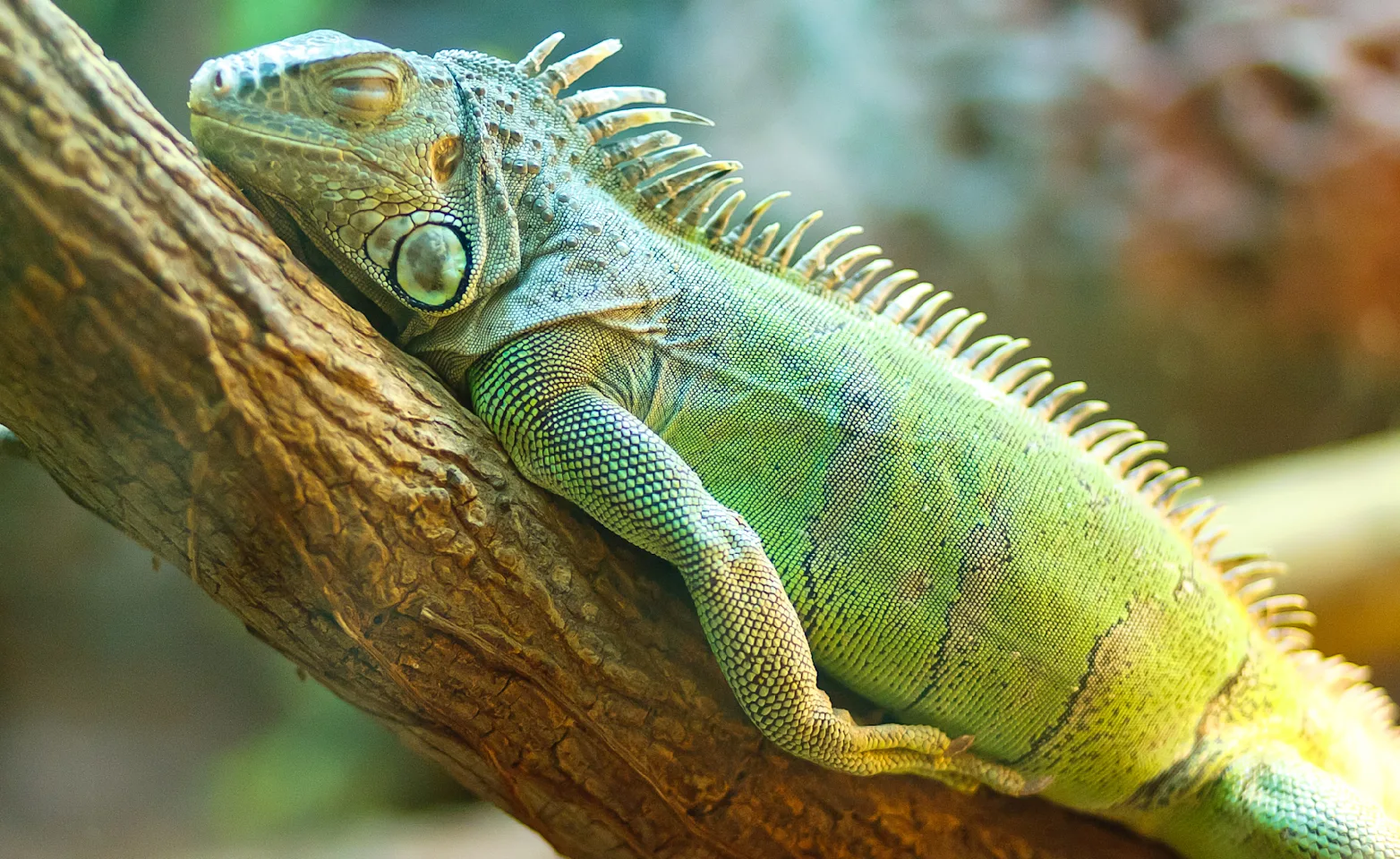Warren Woods Veterinary Hospital

The bearded dragon is part of the Agamidae family of reptiles and is native to Australia’s rocky, dry regions. The beardie is a flat bodied reptile with a triangular head and pointed scales along the sides of its body. They can range in color from light tan to dark brown. Their color is affected by their native soil, so highlights of black, red or gold may be seen. The beardie’s color can vary depending on their mood or temperature; one that is cold or sick may appear darker in color. They can reach a length of 18-24 inches when mature. When threatened, a bearded dragon can inhale air and expand the pouch under its jaw to make itself appear larger. These calm, gentle pets have an average life span of six to twelve years if given the proper care.
Beardies are terrestrial, which means they spend their time on the ground and do not generally climb. Because of this they prefer a long, flat enclosure. The ideal beardie habitat is a long aquarium of at least fifty to sixty gallons with a screen top for ventilation. Substrate for the bottom of your enclosure may include paper towels, newspaper, butcher paper, terrarium liners, rabbit alfalfa food pellets or recycled paper products. Calcium sand is not a good choice because it can be ingested which may cause intestinal impaction. Wood shavings, walnut shells and sand are all inappropriate choices as these can be harmful if ingested, can carry parasites and irritating dusts and oils. The enclosure should be cleaned regularly usually once weekly will suffice; with water and a mild soap. Your beardie will also need a hiding area or small house in the enclosure. Artificial plants and decorations may be used to create a more natural looking habitat, just be sure that your bearded dragon is not ingesting these decorations.
Bearded dragons can be very territorial and should be housed alone. Keeping beardies together despite their gender can result in fighting, injury and death. Bearded dragons should not be housed with different species of reptile because they may fight. They can transmit disease to one another and other reptile species may have different housing or feeding requirements.
A clean water source should be provided in the enclosure. The water dish needs to be large enough for your beardie to be able to soak in and climb out of themselves. The water should be shallow enough that your beardie is not completely submersed. Young bearded dragons might not recognize this as a water source so it is very important to mist them lightly once every day to keep them hydrated. Hatchling beardies can dehydrate quickly and therefore soaking several times a week is very important. This soaking process should involve removing your bearded dragon from its enclosure and allowing it to sit in a shallow warm water bath for 10-15 minutes. The water should be shallow enough so that the beardie can easily keep its head above water.
A heat lamp, ceramic heat emitter is important to maintain the appropriate temperature. The ideal temperature for a bearded dragon is 100-110 degrees Fahrenheit with one side being slightly cooler (about 5 degrees) than the other. This difference in temperature allows your bearded dragon to cool off and avoid overheating. These temperatures are monitored with two thermometers, one on each side of the cage. Your beardie should have 12 hours of daylight (white light) and 12 hours of darkness for its natural biorhythms. A timer purchased from a pet supply store or hardware store can be utilized to maintain this twelve hour light cycle. At night, the temperature in the enclosure should drop slightly, about 10 degrees, as it would in their natural habitat. Night temperatures should also be closely monitored and ceramic heat emitters, red, blue or purple reptile night bulbs can aid in increasing night temperatures if needed. Always use reptile specific heat bulbs which have modifications that benefit the reptile and helps stimulates eating.
An ultraviolet light is essential for the health of bearded dragons. This reptile specific bulb produces UVA and UVB rays and is purchased from your local pet supply store. The UVB rays are important for the natural production of vitamin D which helps the beardie absorb calcium from its diet. Without the UV bulb your beardie cannot properly absorb calcium which leads to metabolic bone disease. UV bulbs for reptiles come in two different forms the compact (coil) bulb and the linear florescent tube. While there are many companies that produce UV bulbs, Zoo Med and Zilla are recommended. Follow manufacturer recommendations to determine the type of UV bulb you purchase, and the distance to place the bulb from your bearded dragon. All UV bulbs need to be changed every 6-12 months based on manufacturer’s recommendations. After that time, even if the bulb still turns on it is not producing the vital rays your beardie needs for calcium metabolism. Plastic and glass windows are designed to block UVB rays so keeping the tank by a window will not provide essential UVB rays. It is ideal to provide monitored time outside on a warm day in an escape proof enclosure with access to shelter. Natural sunlight is the best source of essential UV rays.
Heat rocks should not be used as they can cause burns since reptiles do not sense a “localized” temperature. Heating pads under the tank may be used with supervision. Place your hand on the area of the tank with the heating pad; if it is too hot for your hand to rest on for long periods of time then it is too hot for your bearded dragon.
Bearded dragons are omnivorous, and eat both vegetation and meat. It is important to vary the diet so your beardie receives proper nutrition. Safe foods to offer include gut loaded crickets, mealworms, hornworms, earthworms, roaches, silkworms, butter worms, red worms, phoenix worms, and pre-killed pinkie mice (offer these to adult beardies). Wax worms can be very fattening and super worms are hard to digest so these should be offered less often. Insects should be gut loaded, which means that they are fed nutritious foods before being fed to the beardie. Gut loading food for insects is available at most pet supply stores. Put only the amount of live food in the cage as the reptile will eat at one time, an insect in the cage may chew at your beardie and cause injury. Insects should not be larger than one half to three quarters the size of the space between the beardie’s eyes. Insects larger than this can cause choking. A commercial bearded dragon food may also be offered. A juvenile (under one year of age) will require approximately 80% insects and 20% greens. An adult requires approximately 80% greens and 20% insects. The best time to feed a beardie is in the morning after it has a few hours to warm up.
Greens that can be offered include dandelion greens, collard greens, chicory greens, turnip greens, escarole, endive, romaine, mustard, and turnip greens. Vegetables that may be offered include green beans, peas, cucumber, zucchini, green peppers, and bell peppers. Orange veggies such as carrots, squash, and sweet potatoes are very good sources of vitamin A. Fruits such as strawberries, apples, grapes, cantaloupe, papaya, mango, blueberries, bananas, and berries can be included in the lizard’s diet. Iceberg lettuce has no nutritional value and should not be fed. Spinach, broccoli, cauliflower, cabbage, and other cruciferous vegetables cannot be fed as they contain oxalates that bind calcium intake. A bearded dragon should never be fed bugs found outside as these could be contaminated with pesticide, parasites, or disease. Fireflies and box elder bugs are toxic and should never be fed. Avocado and rhubarb can also be fatal if eaten and should be avoided. Bearded dragons do not produce enough calcium themselves and therefore it must be supplemented in their food. This can be done by purchasing a calcium D3 powder from your local area pet store. This powder is sprinkled on food 3-4 times a week for juvenile beardies (under one year old) or breeding females and 2-3 times a week for adult beardies. The powder can be applied to live food by placing the food and powder in a bag and lightly shaking to coat the food.
Brumation is similar to hibernation. This is a state in which the reptile’s metabolic rate slows down and your beardie’s appetite and activity will drastically decrease. Brumation should only be attempted by an experienced reptile keeper with aid from a reptile veterinarian. Brumation is an instinctual act, usually during the cooler months, stimulated by your beardie’s natural instincts along with differences in the temperature of the environment and the shortening of days. Maintaining the same temperature and light cycle in your enclosure during the winter months will help prevent brumation.
It is important to handle your beardie carefully. When lifting the reptile, support the belly and tail; they should never be picked up by their tail. They will sometimes grip the handler to avoid falling because they are not good climbers. Frequently lifting and holding your beardie will help it remain accustomed to handling. It is also important to thoroughly wash your hands after handling. Bearded dragons are typically very friendly, docile and calm pets.
An annual examination with a reptile veterinarian is important to ensure your beardie is in good health. Bearded dragons are good at hiding illness; this is a survival instinct present in many wild animals. It is important to see a veterinarian if the beardie is acting abnormally or is not eating. Common diseases for beardies may include; intestinal impaction, metabolic bone disease, parasites, respiratory infection, adenovirus, mites and egg binding.
